Capstone Proposal: Impact of At-Risk Environments on School Success
VerifiedAdded on 2022/08/23
|27
|8573
|22
Project
AI Summary
This capstone proposal investigates the significant influence of at-risk environments on children's school success. The study examines how factors such as poverty, single-parent households, and parental guidance affect a child's academic outcomes, mental health, and overall development. The proposal outlines the research questions, literature review, and methodology, including the use of the Strengths and Difficulties Questionnaire (SDQ) to assess emotional, behavioral, and social development. The research aims to provide insights for parents living in at-risk environments, highlighting the importance of understanding the interplay between genetics, environment, and parenting in fostering school success. The proposal reviews existing literature on maternal hardship, income levels, and their impact on academic achievement, emphasizing the need for guidance and support to help children thrive despite challenging circumstances.
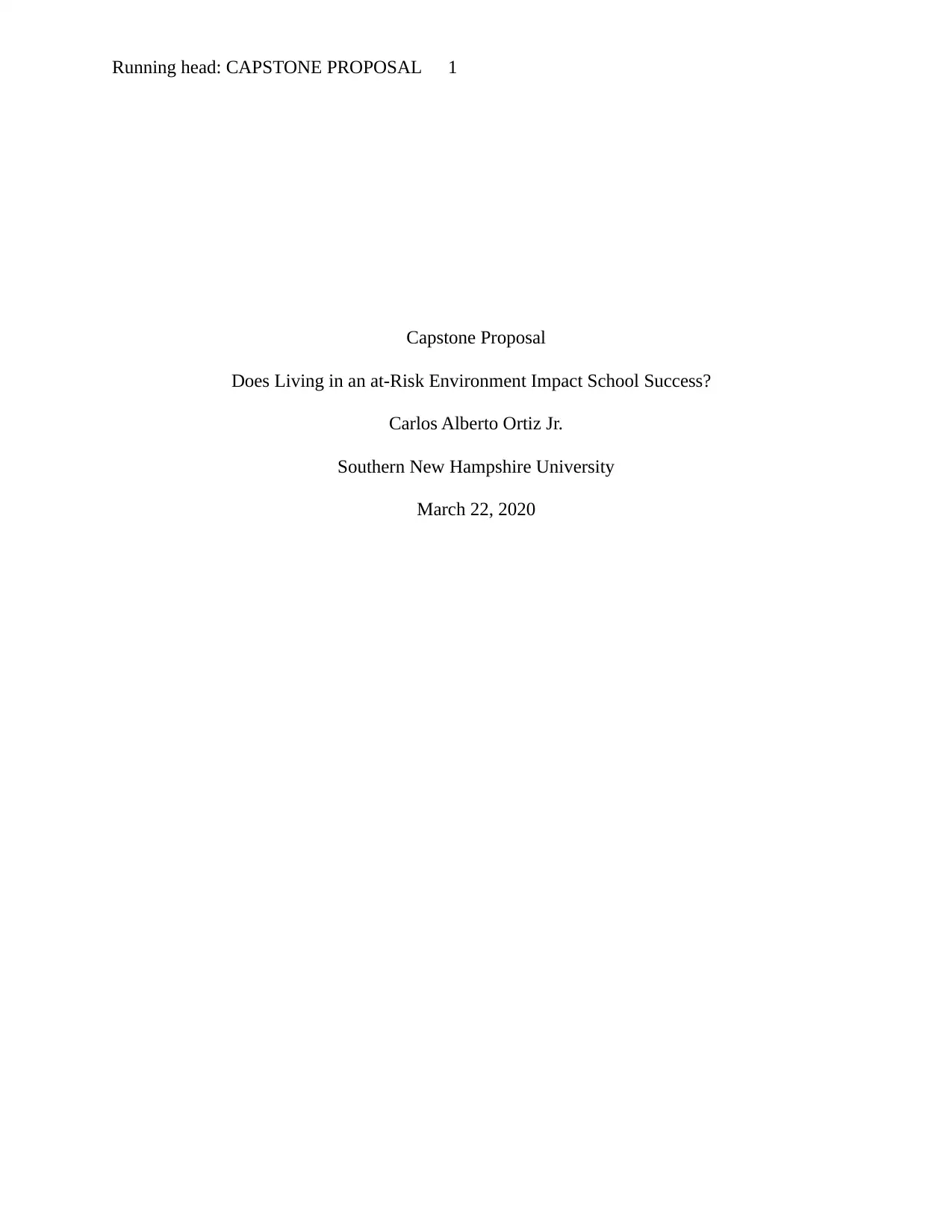
Running head: CAPSTONE PROPOSAL 1
Capstone Proposal
Does Living in an at-Risk Environment Impact School Success?
Carlos Alberto Ortiz Jr.
Southern New Hampshire University
March 22, 2020
Capstone Proposal
Does Living in an at-Risk Environment Impact School Success?
Carlos Alberto Ortiz Jr.
Southern New Hampshire University
March 22, 2020
Paraphrase This Document
Need a fresh take? Get an instant paraphrase of this document with our AI Paraphraser
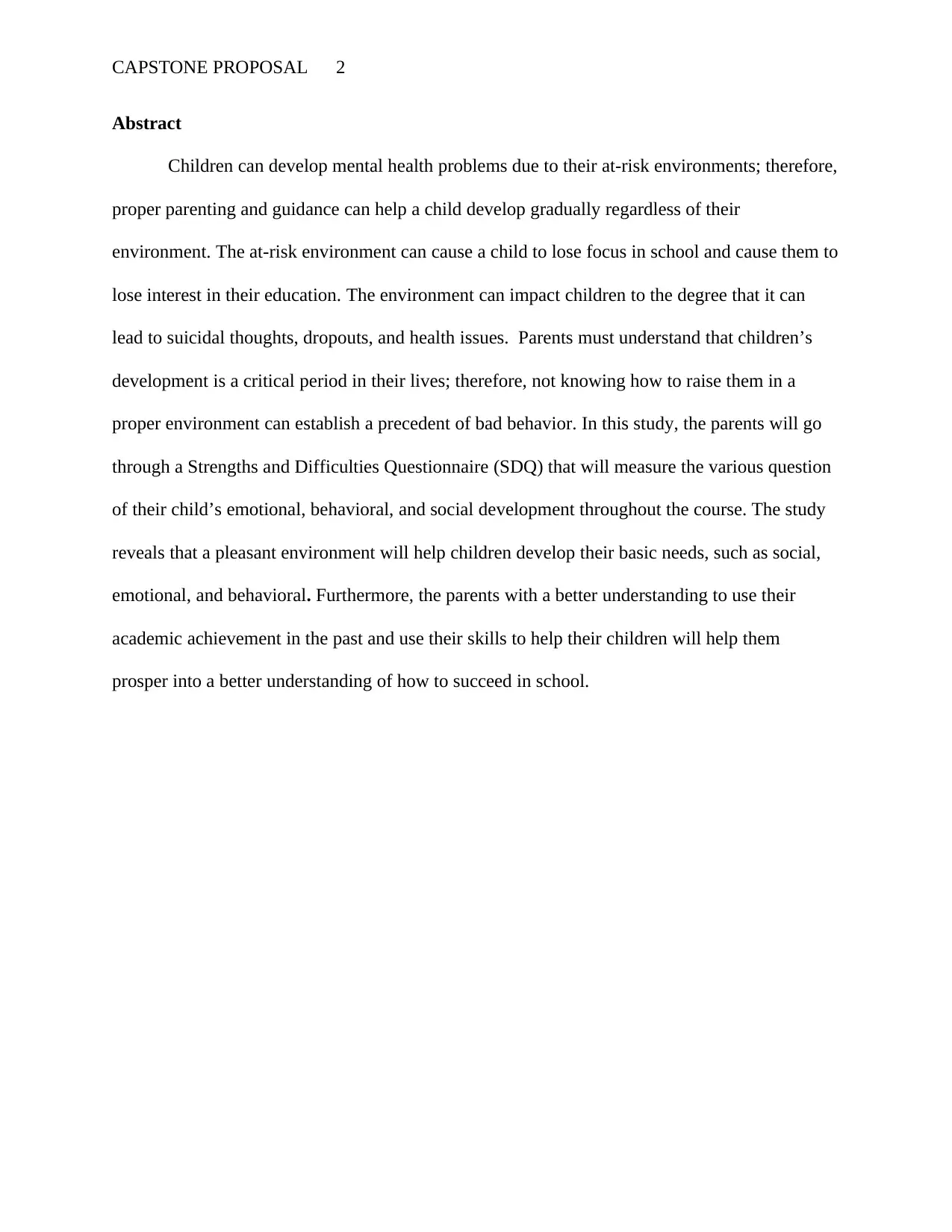
CAPSTONE PROPOSAL 2
Abstract
Children can develop mental health problems due to their at-risk environments; therefore,
proper parenting and guidance can help a child develop gradually regardless of their
environment. The at-risk environment can cause a child to lose focus in school and cause them to
lose interest in their education. The environment can impact children to the degree that it can
lead to suicidal thoughts, dropouts, and health issues. Parents must understand that children’s
development is a critical period in their lives; therefore, not knowing how to raise them in a
proper environment can establish a precedent of bad behavior. In this study, the parents will go
through a Strengths and Difficulties Questionnaire (SDQ) that will measure the various question
of their child’s emotional, behavioral, and social development throughout the course. The study
reveals that a pleasant environment will help children develop their basic needs, such as social,
emotional, and behavioral. Furthermore, the parents with a better understanding to use their
academic achievement in the past and use their skills to help their children will help them
prosper into a better understanding of how to succeed in school.
Abstract
Children can develop mental health problems due to their at-risk environments; therefore,
proper parenting and guidance can help a child develop gradually regardless of their
environment. The at-risk environment can cause a child to lose focus in school and cause them to
lose interest in their education. The environment can impact children to the degree that it can
lead to suicidal thoughts, dropouts, and health issues. Parents must understand that children’s
development is a critical period in their lives; therefore, not knowing how to raise them in a
proper environment can establish a precedent of bad behavior. In this study, the parents will go
through a Strengths and Difficulties Questionnaire (SDQ) that will measure the various question
of their child’s emotional, behavioral, and social development throughout the course. The study
reveals that a pleasant environment will help children develop their basic needs, such as social,
emotional, and behavioral. Furthermore, the parents with a better understanding to use their
academic achievement in the past and use their skills to help their children will help them
prosper into a better understanding of how to succeed in school.
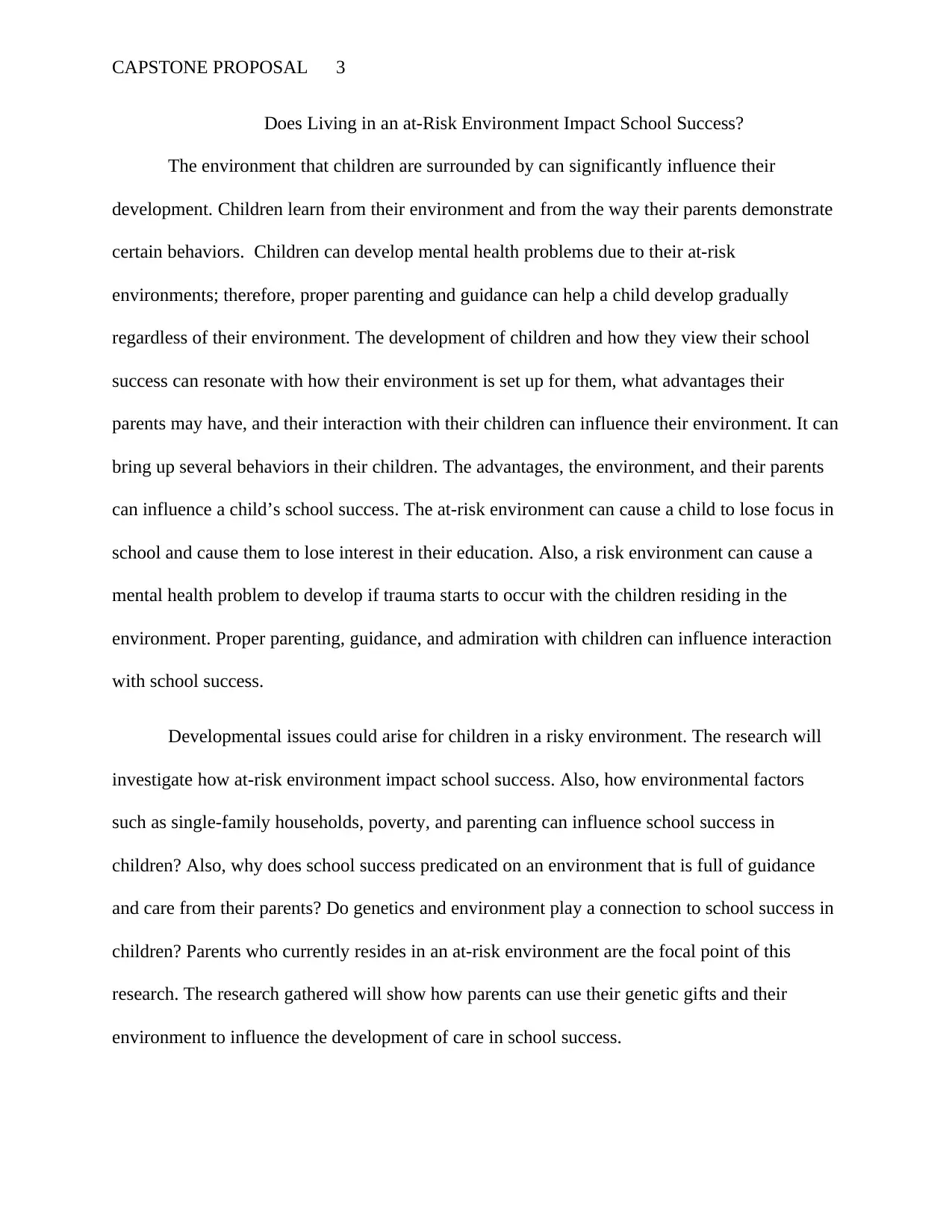
CAPSTONE PROPOSAL 3
Does Living in an at-Risk Environment Impact School Success?
The environment that children are surrounded by can significantly influence their
development. Children learn from their environment and from the way their parents demonstrate
certain behaviors. Children can develop mental health problems due to their at-risk
environments; therefore, proper parenting and guidance can help a child develop gradually
regardless of their environment. The development of children and how they view their school
success can resonate with how their environment is set up for them, what advantages their
parents may have, and their interaction with their children can influence their environment. It can
bring up several behaviors in their children. The advantages, the environment, and their parents
can influence a child’s school success. The at-risk environment can cause a child to lose focus in
school and cause them to lose interest in their education. Also, a risk environment can cause a
mental health problem to develop if trauma starts to occur with the children residing in the
environment. Proper parenting, guidance, and admiration with children can influence interaction
with school success.
Developmental issues could arise for children in a risky environment. The research will
investigate how at-risk environment impact school success. Also, how environmental factors
such as single-family households, poverty, and parenting can influence school success in
children? Also, why does school success predicated on an environment that is full of guidance
and care from their parents? Do genetics and environment play a connection to school success in
children? Parents who currently resides in an at-risk environment are the focal point of this
research. The research gathered will show how parents can use their genetic gifts and their
environment to influence the development of care in school success.
Does Living in an at-Risk Environment Impact School Success?
The environment that children are surrounded by can significantly influence their
development. Children learn from their environment and from the way their parents demonstrate
certain behaviors. Children can develop mental health problems due to their at-risk
environments; therefore, proper parenting and guidance can help a child develop gradually
regardless of their environment. The development of children and how they view their school
success can resonate with how their environment is set up for them, what advantages their
parents may have, and their interaction with their children can influence their environment. It can
bring up several behaviors in their children. The advantages, the environment, and their parents
can influence a child’s school success. The at-risk environment can cause a child to lose focus in
school and cause them to lose interest in their education. Also, a risk environment can cause a
mental health problem to develop if trauma starts to occur with the children residing in the
environment. Proper parenting, guidance, and admiration with children can influence interaction
with school success.
Developmental issues could arise for children in a risky environment. The research will
investigate how at-risk environment impact school success. Also, how environmental factors
such as single-family households, poverty, and parenting can influence school success in
children? Also, why does school success predicated on an environment that is full of guidance
and care from their parents? Do genetics and environment play a connection to school success in
children? Parents who currently resides in an at-risk environment are the focal point of this
research. The research gathered will show how parents can use their genetic gifts and their
environment to influence the development of care in school success.
⊘ This is a preview!⊘
Do you want full access?
Subscribe today to unlock all pages.

Trusted by 1+ million students worldwide
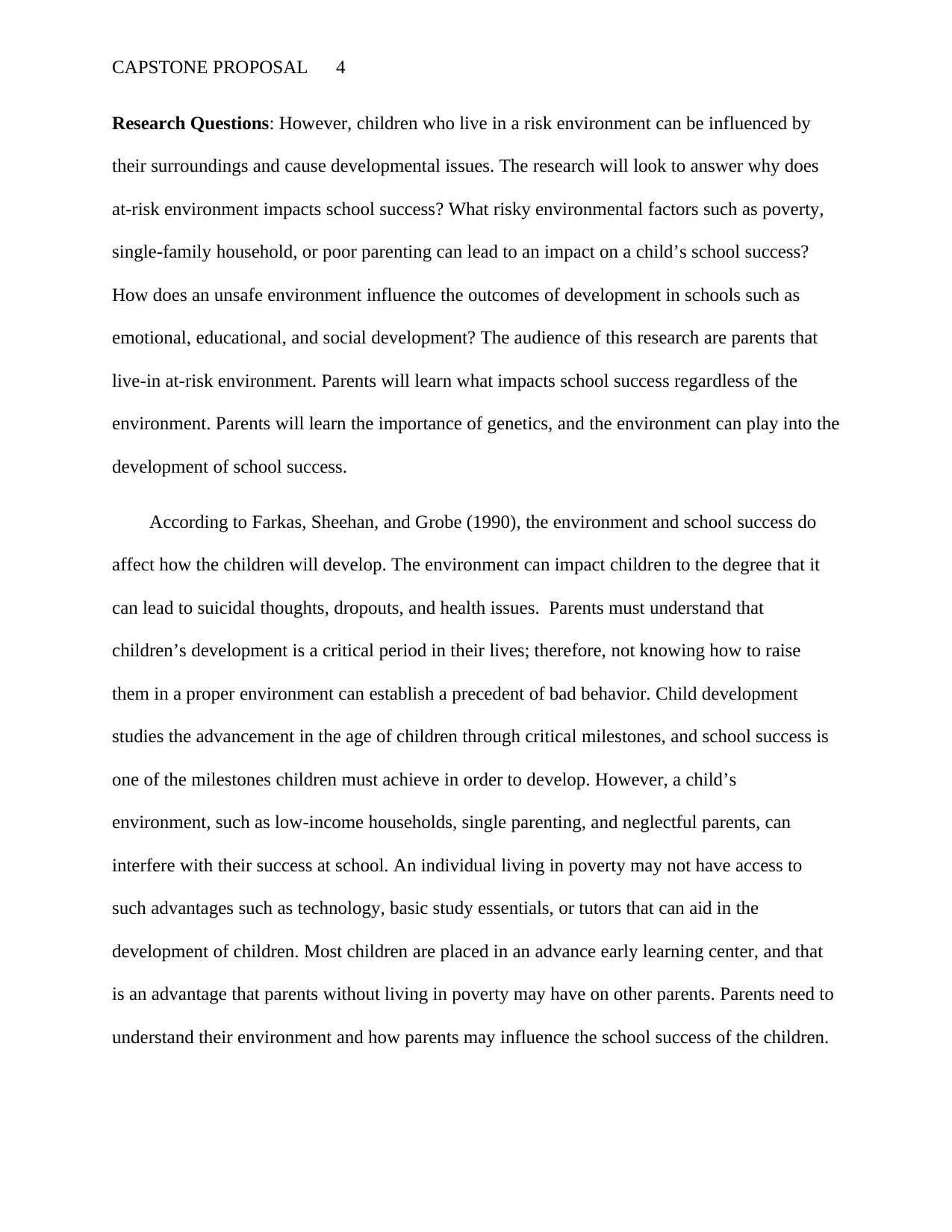
CAPSTONE PROPOSAL 4
Research Questions: However, children who live in a risk environment can be influenced by
their surroundings and cause developmental issues. The research will look to answer why does
at-risk environment impacts school success? What risky environmental factors such as poverty,
single-family household, or poor parenting can lead to an impact on a child’s school success?
How does an unsafe environment influence the outcomes of development in schools such as
emotional, educational, and social development? The audience of this research are parents that
live-in at-risk environment. Parents will learn what impacts school success regardless of the
environment. Parents will learn the importance of genetics, and the environment can play into the
development of school success.
According to Farkas, Sheehan, and Grobe (1990), the environment and school success do
affect how the children will develop. The environment can impact children to the degree that it
can lead to suicidal thoughts, dropouts, and health issues. Parents must understand that
children’s development is a critical period in their lives; therefore, not knowing how to raise
them in a proper environment can establish a precedent of bad behavior. Child development
studies the advancement in the age of children through critical milestones, and school success is
one of the milestones children must achieve in order to develop. However, a child’s
environment, such as low-income households, single parenting, and neglectful parents, can
interfere with their success at school. An individual living in poverty may not have access to
such advantages such as technology, basic study essentials, or tutors that can aid in the
development of children. Most children are placed in an advance early learning center, and that
is an advantage that parents without living in poverty may have on other parents. Parents need to
understand their environment and how parents may influence the school success of the children.
Research Questions: However, children who live in a risk environment can be influenced by
their surroundings and cause developmental issues. The research will look to answer why does
at-risk environment impacts school success? What risky environmental factors such as poverty,
single-family household, or poor parenting can lead to an impact on a child’s school success?
How does an unsafe environment influence the outcomes of development in schools such as
emotional, educational, and social development? The audience of this research are parents that
live-in at-risk environment. Parents will learn what impacts school success regardless of the
environment. Parents will learn the importance of genetics, and the environment can play into the
development of school success.
According to Farkas, Sheehan, and Grobe (1990), the environment and school success do
affect how the children will develop. The environment can impact children to the degree that it
can lead to suicidal thoughts, dropouts, and health issues. Parents must understand that
children’s development is a critical period in their lives; therefore, not knowing how to raise
them in a proper environment can establish a precedent of bad behavior. Child development
studies the advancement in the age of children through critical milestones, and school success is
one of the milestones children must achieve in order to develop. However, a child’s
environment, such as low-income households, single parenting, and neglectful parents, can
interfere with their success at school. An individual living in poverty may not have access to
such advantages such as technology, basic study essentials, or tutors that can aid in the
development of children. Most children are placed in an advance early learning center, and that
is an advantage that parents without living in poverty may have on other parents. Parents need to
understand their environment and how parents may influence the school success of the children.
Paraphrase This Document
Need a fresh take? Get an instant paraphrase of this document with our AI Paraphraser
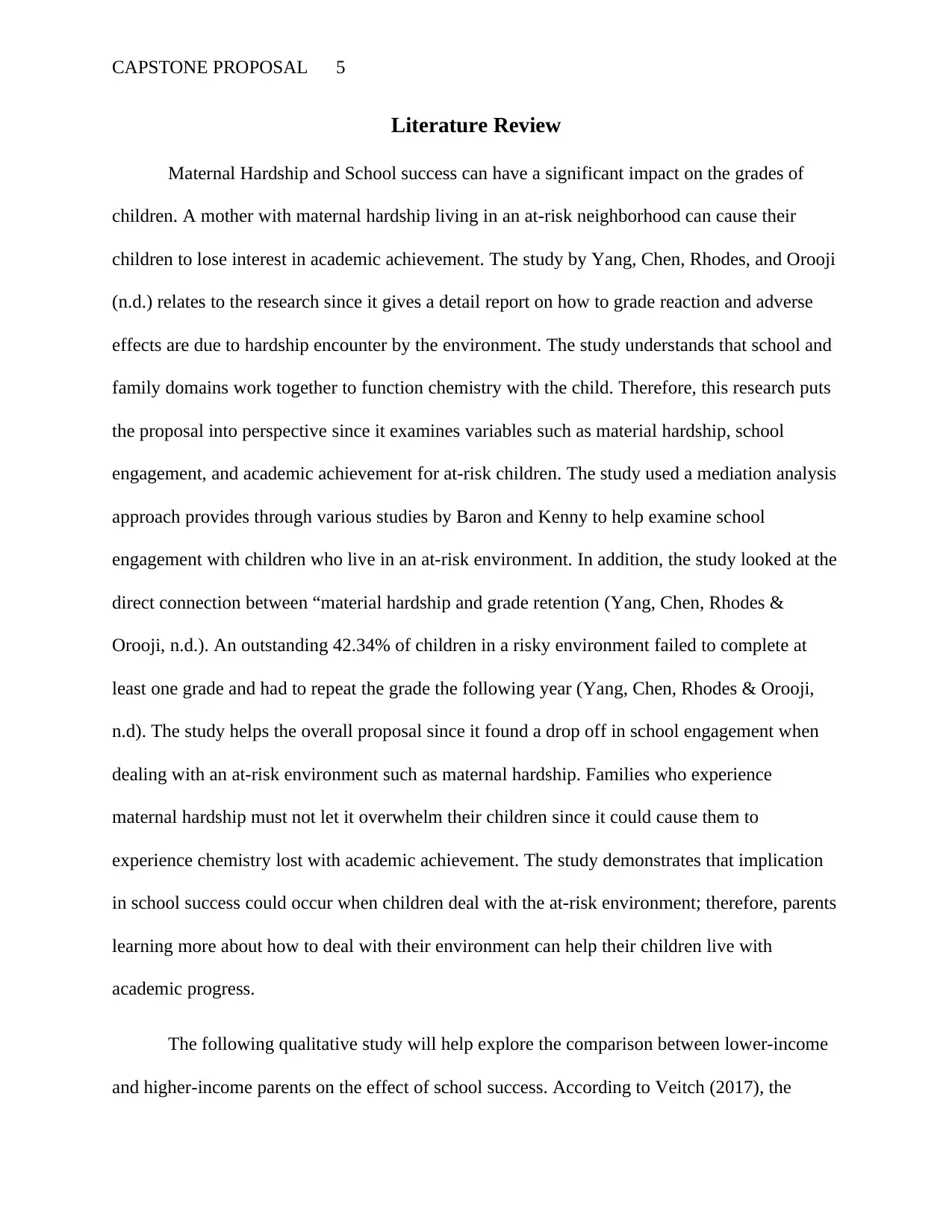
CAPSTONE PROPOSAL 5
Literature Review
Maternal Hardship and School success can have a significant impact on the grades of
children. A mother with maternal hardship living in an at-risk neighborhood can cause their
children to lose interest in academic achievement. The study by Yang, Chen, Rhodes, and Orooji
(n.d.) relates to the research since it gives a detail report on how to grade reaction and adverse
effects are due to hardship encounter by the environment. The study understands that school and
family domains work together to function chemistry with the child. Therefore, this research puts
the proposal into perspective since it examines variables such as material hardship, school
engagement, and academic achievement for at-risk children. The study used a mediation analysis
approach provides through various studies by Baron and Kenny to help examine school
engagement with children who live in an at-risk environment. In addition, the study looked at the
direct connection between “material hardship and grade retention (Yang, Chen, Rhodes &
Orooji, n.d.). An outstanding 42.34% of children in a risky environment failed to complete at
least one grade and had to repeat the grade the following year (Yang, Chen, Rhodes & Orooji,
n.d). The study helps the overall proposal since it found a drop off in school engagement when
dealing with an at-risk environment such as maternal hardship. Families who experience
maternal hardship must not let it overwhelm their children since it could cause them to
experience chemistry lost with academic achievement. The study demonstrates that implication
in school success could occur when children deal with the at-risk environment; therefore, parents
learning more about how to deal with their environment can help their children live with
academic progress.
The following qualitative study will help explore the comparison between lower-income
and higher-income parents on the effect of school success. According to Veitch (2017), the
Literature Review
Maternal Hardship and School success can have a significant impact on the grades of
children. A mother with maternal hardship living in an at-risk neighborhood can cause their
children to lose interest in academic achievement. The study by Yang, Chen, Rhodes, and Orooji
(n.d.) relates to the research since it gives a detail report on how to grade reaction and adverse
effects are due to hardship encounter by the environment. The study understands that school and
family domains work together to function chemistry with the child. Therefore, this research puts
the proposal into perspective since it examines variables such as material hardship, school
engagement, and academic achievement for at-risk children. The study used a mediation analysis
approach provides through various studies by Baron and Kenny to help examine school
engagement with children who live in an at-risk environment. In addition, the study looked at the
direct connection between “material hardship and grade retention (Yang, Chen, Rhodes &
Orooji, n.d.). An outstanding 42.34% of children in a risky environment failed to complete at
least one grade and had to repeat the grade the following year (Yang, Chen, Rhodes & Orooji,
n.d). The study helps the overall proposal since it found a drop off in school engagement when
dealing with an at-risk environment such as maternal hardship. Families who experience
maternal hardship must not let it overwhelm their children since it could cause them to
experience chemistry lost with academic achievement. The study demonstrates that implication
in school success could occur when children deal with the at-risk environment; therefore, parents
learning more about how to deal with their environment can help their children live with
academic progress.
The following qualitative study will help explore the comparison between lower-income
and higher-income parents on the effect of school success. According to Veitch (2017), the
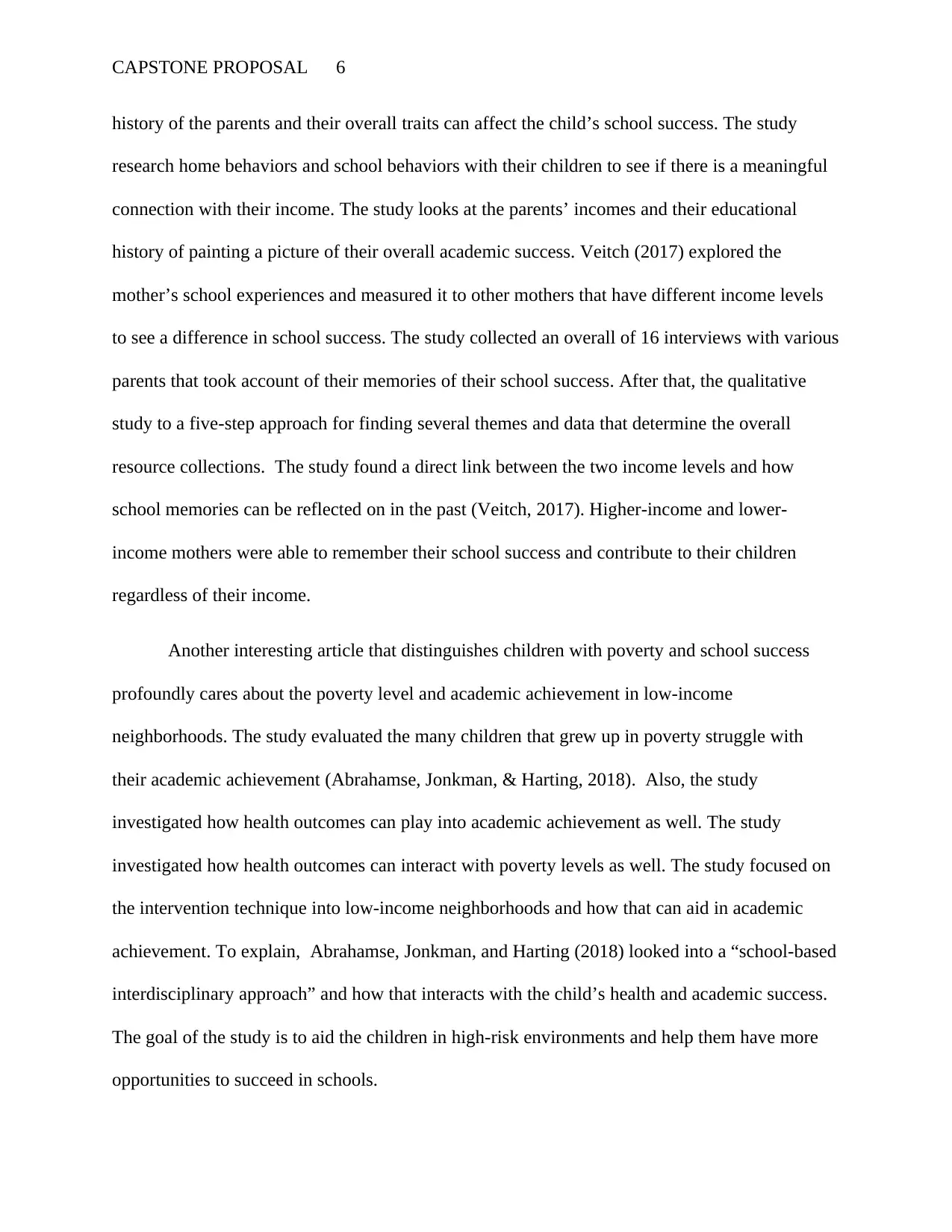
CAPSTONE PROPOSAL 6
history of the parents and their overall traits can affect the child’s school success. The study
research home behaviors and school behaviors with their children to see if there is a meaningful
connection with their income. The study looks at the parents’ incomes and their educational
history of painting a picture of their overall academic success. Veitch (2017) explored the
mother’s school experiences and measured it to other mothers that have different income levels
to see a difference in school success. The study collected an overall of 16 interviews with various
parents that took account of their memories of their school success. After that, the qualitative
study to a five-step approach for finding several themes and data that determine the overall
resource collections. The study found a direct link between the two income levels and how
school memories can be reflected on in the past (Veitch, 2017). Higher-income and lower-
income mothers were able to remember their school success and contribute to their children
regardless of their income.
Another interesting article that distinguishes children with poverty and school success
profoundly cares about the poverty level and academic achievement in low-income
neighborhoods. The study evaluated the many children that grew up in poverty struggle with
their academic achievement (Abrahamse, Jonkman, & Harting, 2018). Also, the study
investigated how health outcomes can play into academic achievement as well. The study
investigated how health outcomes can interact with poverty levels as well. The study focused on
the intervention technique into low-income neighborhoods and how that can aid in academic
achievement. To explain, Abrahamse, Jonkman, and Harting (2018) looked into a “school-based
interdisciplinary approach” and how that interacts with the child’s health and academic success.
The goal of the study is to aid the children in high-risk environments and help them have more
opportunities to succeed in schools.
history of the parents and their overall traits can affect the child’s school success. The study
research home behaviors and school behaviors with their children to see if there is a meaningful
connection with their income. The study looks at the parents’ incomes and their educational
history of painting a picture of their overall academic success. Veitch (2017) explored the
mother’s school experiences and measured it to other mothers that have different income levels
to see a difference in school success. The study collected an overall of 16 interviews with various
parents that took account of their memories of their school success. After that, the qualitative
study to a five-step approach for finding several themes and data that determine the overall
resource collections. The study found a direct link between the two income levels and how
school memories can be reflected on in the past (Veitch, 2017). Higher-income and lower-
income mothers were able to remember their school success and contribute to their children
regardless of their income.
Another interesting article that distinguishes children with poverty and school success
profoundly cares about the poverty level and academic achievement in low-income
neighborhoods. The study evaluated the many children that grew up in poverty struggle with
their academic achievement (Abrahamse, Jonkman, & Harting, 2018). Also, the study
investigated how health outcomes can play into academic achievement as well. The study
investigated how health outcomes can interact with poverty levels as well. The study focused on
the intervention technique into low-income neighborhoods and how that can aid in academic
achievement. To explain, Abrahamse, Jonkman, and Harting (2018) looked into a “school-based
interdisciplinary approach” and how that interacts with the child’s health and academic success.
The goal of the study is to aid the children in high-risk environments and help them have more
opportunities to succeed in schools.
⊘ This is a preview!⊘
Do you want full access?
Subscribe today to unlock all pages.

Trusted by 1+ million students worldwide
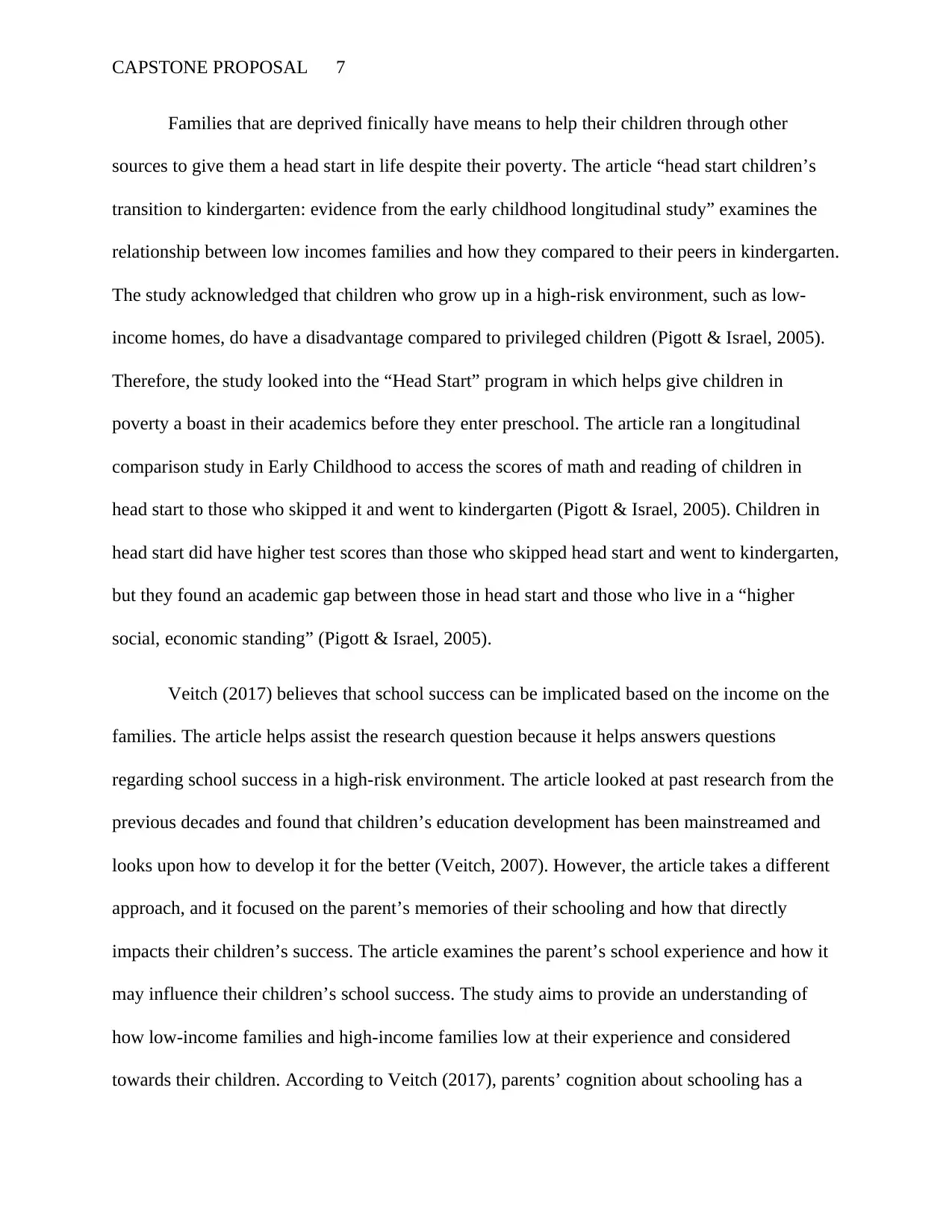
CAPSTONE PROPOSAL 7
Families that are deprived finically have means to help their children through other
sources to give them a head start in life despite their poverty. The article “head start children’s
transition to kindergarten: evidence from the early childhood longitudinal study” examines the
relationship between low incomes families and how they compared to their peers in kindergarten.
The study acknowledged that children who grow up in a high-risk environment, such as low-
income homes, do have a disadvantage compared to privileged children (Pigott & Israel, 2005).
Therefore, the study looked into the “Head Start” program in which helps give children in
poverty a boast in their academics before they enter preschool. The article ran a longitudinal
comparison study in Early Childhood to access the scores of math and reading of children in
head start to those who skipped it and went to kindergarten (Pigott & Israel, 2005). Children in
head start did have higher test scores than those who skipped head start and went to kindergarten,
but they found an academic gap between those in head start and those who live in a “higher
social, economic standing” (Pigott & Israel, 2005).
Veitch (2017) believes that school success can be implicated based on the income on the
families. The article helps assist the research question because it helps answers questions
regarding school success in a high-risk environment. The article looked at past research from the
previous decades and found that children’s education development has been mainstreamed and
looks upon how to develop it for the better (Veitch, 2007). However, the article takes a different
approach, and it focused on the parent’s memories of their schooling and how that directly
impacts their children’s success. The article examines the parent’s school experience and how it
may influence their children’s school success. The study aims to provide an understanding of
how low-income families and high-income families low at their experience and considered
towards their children. According to Veitch (2017), parents’ cognition about schooling has a
Families that are deprived finically have means to help their children through other
sources to give them a head start in life despite their poverty. The article “head start children’s
transition to kindergarten: evidence from the early childhood longitudinal study” examines the
relationship between low incomes families and how they compared to their peers in kindergarten.
The study acknowledged that children who grow up in a high-risk environment, such as low-
income homes, do have a disadvantage compared to privileged children (Pigott & Israel, 2005).
Therefore, the study looked into the “Head Start” program in which helps give children in
poverty a boast in their academics before they enter preschool. The article ran a longitudinal
comparison study in Early Childhood to access the scores of math and reading of children in
head start to those who skipped it and went to kindergarten (Pigott & Israel, 2005). Children in
head start did have higher test scores than those who skipped head start and went to kindergarten,
but they found an academic gap between those in head start and those who live in a “higher
social, economic standing” (Pigott & Israel, 2005).
Veitch (2017) believes that school success can be implicated based on the income on the
families. The article helps assist the research question because it helps answers questions
regarding school success in a high-risk environment. The article looked at past research from the
previous decades and found that children’s education development has been mainstreamed and
looks upon how to develop it for the better (Veitch, 2007). However, the article takes a different
approach, and it focused on the parent’s memories of their schooling and how that directly
impacts their children’s success. The article examines the parent’s school experience and how it
may influence their children’s school success. The study aims to provide an understanding of
how low-income families and high-income families low at their experience and considered
towards their children. According to Veitch (2017), parents’ cognition about schooling has a
Paraphrase This Document
Need a fresh take? Get an instant paraphrase of this document with our AI Paraphraser
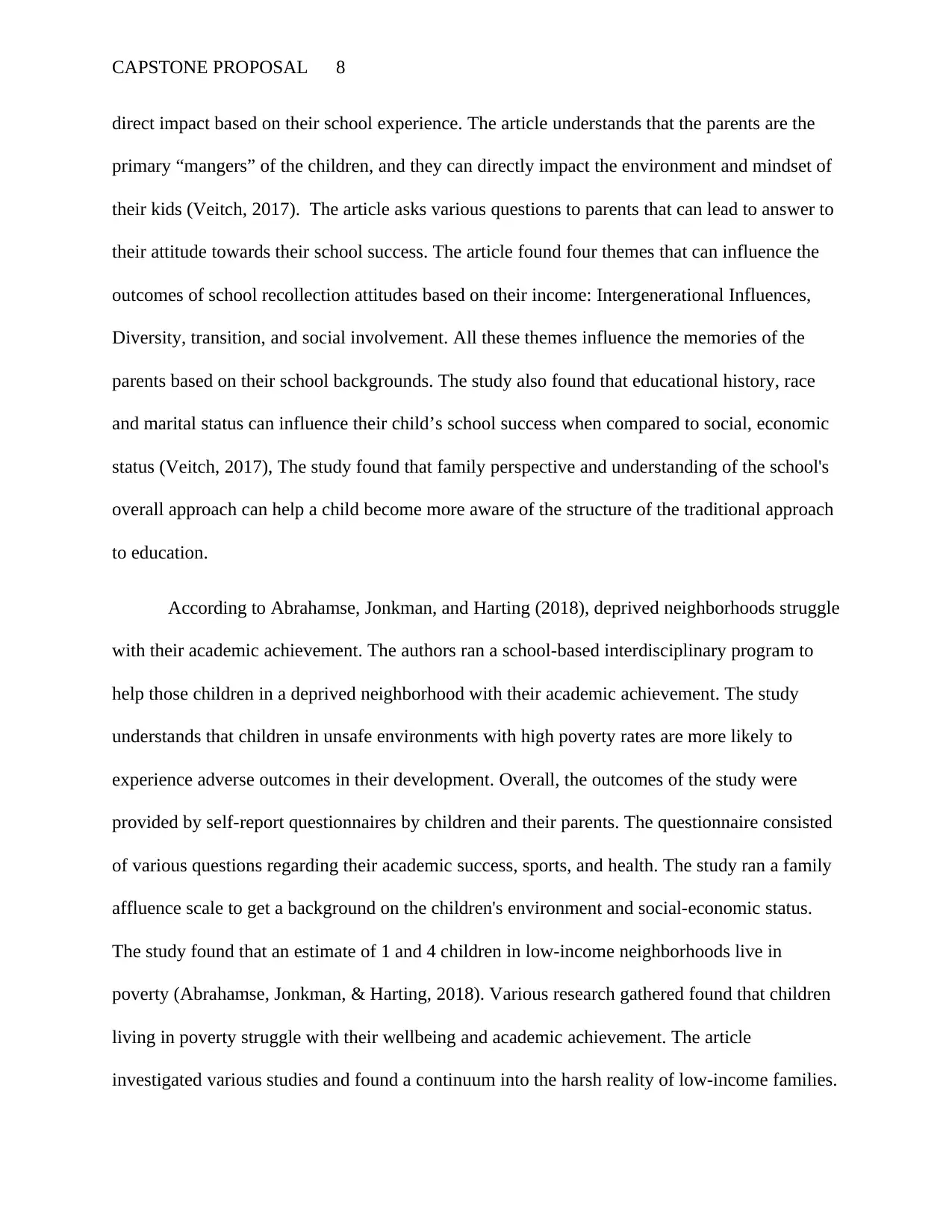
CAPSTONE PROPOSAL 8
direct impact based on their school experience. The article understands that the parents are the
primary “mangers” of the children, and they can directly impact the environment and mindset of
their kids (Veitch, 2017). The article asks various questions to parents that can lead to answer to
their attitude towards their school success. The article found four themes that can influence the
outcomes of school recollection attitudes based on their income: Intergenerational Influences,
Diversity, transition, and social involvement. All these themes influence the memories of the
parents based on their school backgrounds. The study also found that educational history, race
and marital status can influence their child’s school success when compared to social, economic
status (Veitch, 2017), The study found that family perspective and understanding of the school's
overall approach can help a child become more aware of the structure of the traditional approach
to education.
According to Abrahamse, Jonkman, and Harting (2018), deprived neighborhoods struggle
with their academic achievement. The authors ran a school-based interdisciplinary program to
help those children in a deprived neighborhood with their academic achievement. The study
understands that children in unsafe environments with high poverty rates are more likely to
experience adverse outcomes in their development. Overall, the outcomes of the study were
provided by self-report questionnaires by children and their parents. The questionnaire consisted
of various questions regarding their academic success, sports, and health. The study ran a family
affluence scale to get a background on the children's environment and social-economic status.
The study found that an estimate of 1 and 4 children in low-income neighborhoods live in
poverty (Abrahamse, Jonkman, & Harting, 2018). Various research gathered found that children
living in poverty struggle with their wellbeing and academic achievement. The article
investigated various studies and found a continuum into the harsh reality of low-income families.
direct impact based on their school experience. The article understands that the parents are the
primary “mangers” of the children, and they can directly impact the environment and mindset of
their kids (Veitch, 2017). The article asks various questions to parents that can lead to answer to
their attitude towards their school success. The article found four themes that can influence the
outcomes of school recollection attitudes based on their income: Intergenerational Influences,
Diversity, transition, and social involvement. All these themes influence the memories of the
parents based on their school backgrounds. The study also found that educational history, race
and marital status can influence their child’s school success when compared to social, economic
status (Veitch, 2017), The study found that family perspective and understanding of the school's
overall approach can help a child become more aware of the structure of the traditional approach
to education.
According to Abrahamse, Jonkman, and Harting (2018), deprived neighborhoods struggle
with their academic achievement. The authors ran a school-based interdisciplinary program to
help those children in a deprived neighborhood with their academic achievement. The study
understands that children in unsafe environments with high poverty rates are more likely to
experience adverse outcomes in their development. Overall, the outcomes of the study were
provided by self-report questionnaires by children and their parents. The questionnaire consisted
of various questions regarding their academic success, sports, and health. The study ran a family
affluence scale to get a background on the children's environment and social-economic status.
The study found that an estimate of 1 and 4 children in low-income neighborhoods live in
poverty (Abrahamse, Jonkman, & Harting, 2018). Various research gathered found that children
living in poverty struggle with their wellbeing and academic achievement. The article
investigated various studies and found a continuum into the harsh reality of low-income families.
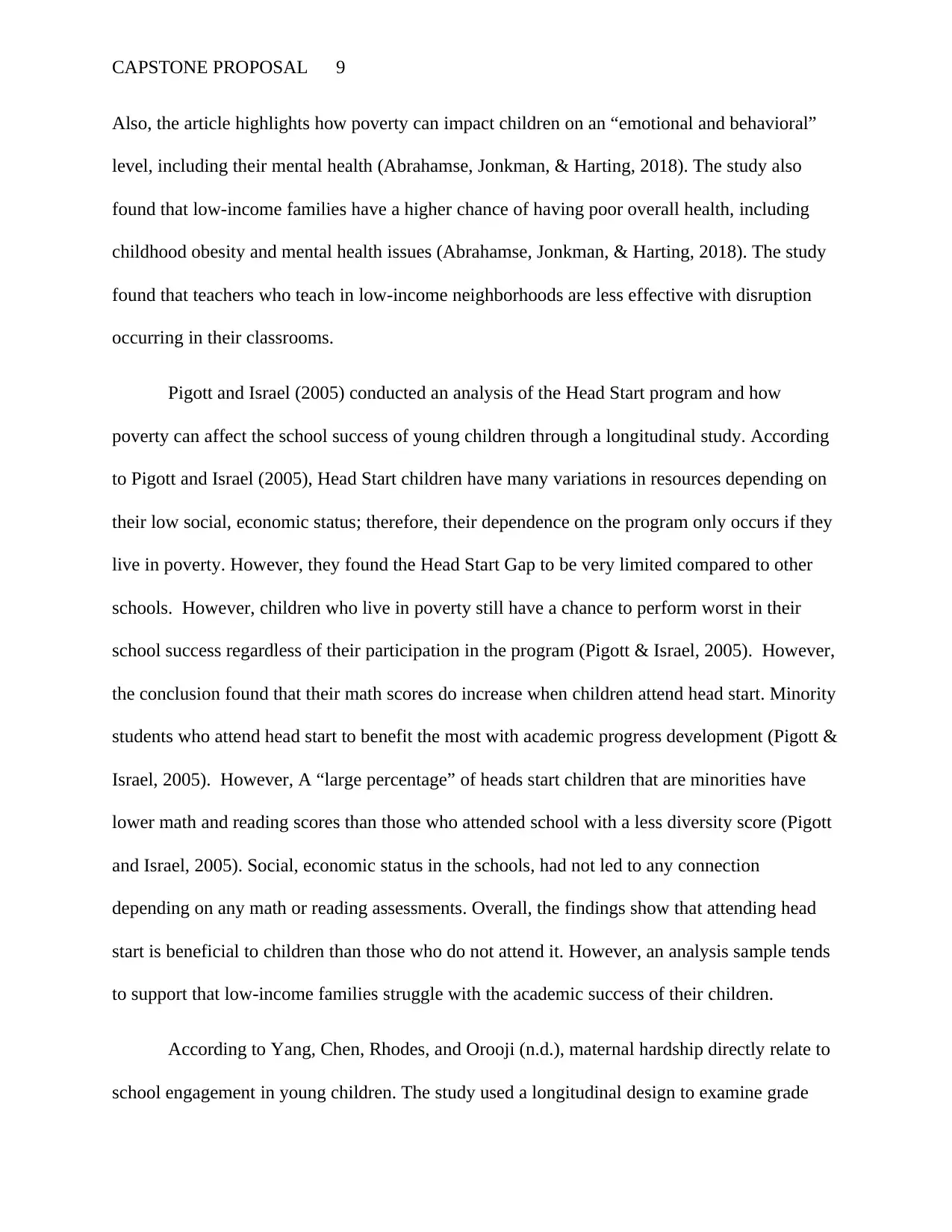
CAPSTONE PROPOSAL 9
Also, the article highlights how poverty can impact children on an “emotional and behavioral”
level, including their mental health (Abrahamse, Jonkman, & Harting, 2018). The study also
found that low-income families have a higher chance of having poor overall health, including
childhood obesity and mental health issues (Abrahamse, Jonkman, & Harting, 2018). The study
found that teachers who teach in low-income neighborhoods are less effective with disruption
occurring in their classrooms.
Pigott and Israel (2005) conducted an analysis of the Head Start program and how
poverty can affect the school success of young children through a longitudinal study. According
to Pigott and Israel (2005), Head Start children have many variations in resources depending on
their low social, economic status; therefore, their dependence on the program only occurs if they
live in poverty. However, they found the Head Start Gap to be very limited compared to other
schools. However, children who live in poverty still have a chance to perform worst in their
school success regardless of their participation in the program (Pigott & Israel, 2005). However,
the conclusion found that their math scores do increase when children attend head start. Minority
students who attend head start to benefit the most with academic progress development (Pigott &
Israel, 2005). However, A “large percentage” of heads start children that are minorities have
lower math and reading scores than those who attended school with a less diversity score (Pigott
and Israel, 2005). Social, economic status in the schools, had not led to any connection
depending on any math or reading assessments. Overall, the findings show that attending head
start is beneficial to children than those who do not attend it. However, an analysis sample tends
to support that low-income families struggle with the academic success of their children.
According to Yang, Chen, Rhodes, and Orooji (n.d.), maternal hardship directly relate to
school engagement in young children. The study used a longitudinal design to examine grade
Also, the article highlights how poverty can impact children on an “emotional and behavioral”
level, including their mental health (Abrahamse, Jonkman, & Harting, 2018). The study also
found that low-income families have a higher chance of having poor overall health, including
childhood obesity and mental health issues (Abrahamse, Jonkman, & Harting, 2018). The study
found that teachers who teach in low-income neighborhoods are less effective with disruption
occurring in their classrooms.
Pigott and Israel (2005) conducted an analysis of the Head Start program and how
poverty can affect the school success of young children through a longitudinal study. According
to Pigott and Israel (2005), Head Start children have many variations in resources depending on
their low social, economic status; therefore, their dependence on the program only occurs if they
live in poverty. However, they found the Head Start Gap to be very limited compared to other
schools. However, children who live in poverty still have a chance to perform worst in their
school success regardless of their participation in the program (Pigott & Israel, 2005). However,
the conclusion found that their math scores do increase when children attend head start. Minority
students who attend head start to benefit the most with academic progress development (Pigott &
Israel, 2005). However, A “large percentage” of heads start children that are minorities have
lower math and reading scores than those who attended school with a less diversity score (Pigott
and Israel, 2005). Social, economic status in the schools, had not led to any connection
depending on any math or reading assessments. Overall, the findings show that attending head
start is beneficial to children than those who do not attend it. However, an analysis sample tends
to support that low-income families struggle with the academic success of their children.
According to Yang, Chen, Rhodes, and Orooji (n.d.), maternal hardship directly relate to
school engagement in young children. The study used a longitudinal design to examine grade
⊘ This is a preview!⊘
Do you want full access?
Subscribe today to unlock all pages.

Trusted by 1+ million students worldwide
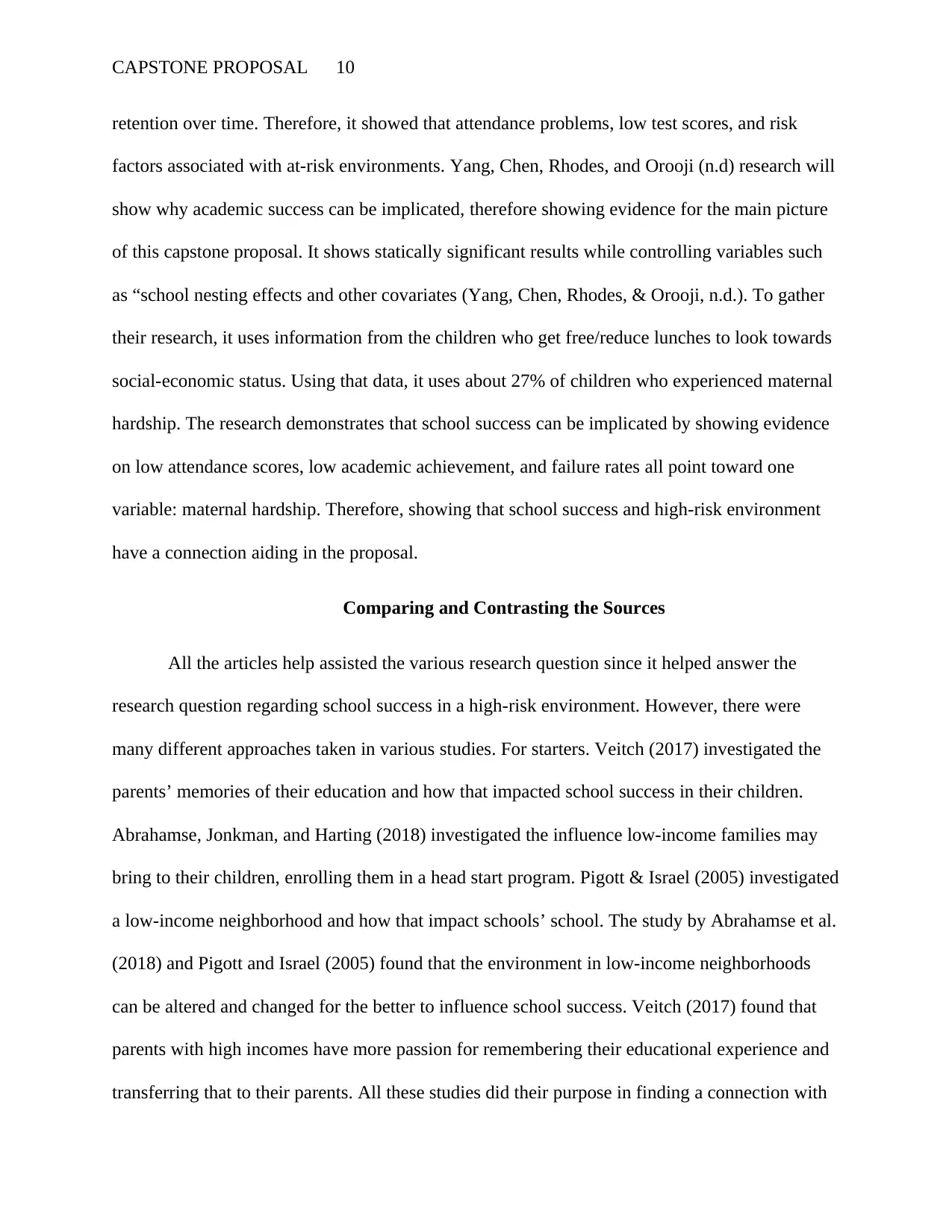
CAPSTONE PROPOSAL 10
retention over time. Therefore, it showed that attendance problems, low test scores, and risk
factors associated with at-risk environments. Yang, Chen, Rhodes, and Orooji (n.d) research will
show why academic success can be implicated, therefore showing evidence for the main picture
of this capstone proposal. It shows statically significant results while controlling variables such
as “school nesting effects and other covariates (Yang, Chen, Rhodes, & Orooji, n.d.). To gather
their research, it uses information from the children who get free/reduce lunches to look towards
social-economic status. Using that data, it uses about 27% of children who experienced maternal
hardship. The research demonstrates that school success can be implicated by showing evidence
on low attendance scores, low academic achievement, and failure rates all point toward one
variable: maternal hardship. Therefore, showing that school success and high-risk environment
have a connection aiding in the proposal.
Comparing and Contrasting the Sources
All the articles help assisted the various research question since it helped answer the
research question regarding school success in a high-risk environment. However, there were
many different approaches taken in various studies. For starters. Veitch (2017) investigated the
parents’ memories of their education and how that impacted school success in their children.
Abrahamse, Jonkman, and Harting (2018) investigated the influence low-income families may
bring to their children, enrolling them in a head start program. Pigott & Israel (2005) investigated
a low-income neighborhood and how that impact schools’ school. The study by Abrahamse et al.
(2018) and Pigott and Israel (2005) found that the environment in low-income neighborhoods
can be altered and changed for the better to influence school success. Veitch (2017) found that
parents with high incomes have more passion for remembering their educational experience and
transferring that to their parents. All these studies did their purpose in finding a connection with
retention over time. Therefore, it showed that attendance problems, low test scores, and risk
factors associated with at-risk environments. Yang, Chen, Rhodes, and Orooji (n.d) research will
show why academic success can be implicated, therefore showing evidence for the main picture
of this capstone proposal. It shows statically significant results while controlling variables such
as “school nesting effects and other covariates (Yang, Chen, Rhodes, & Orooji, n.d.). To gather
their research, it uses information from the children who get free/reduce lunches to look towards
social-economic status. Using that data, it uses about 27% of children who experienced maternal
hardship. The research demonstrates that school success can be implicated by showing evidence
on low attendance scores, low academic achievement, and failure rates all point toward one
variable: maternal hardship. Therefore, showing that school success and high-risk environment
have a connection aiding in the proposal.
Comparing and Contrasting the Sources
All the articles help assisted the various research question since it helped answer the
research question regarding school success in a high-risk environment. However, there were
many different approaches taken in various studies. For starters. Veitch (2017) investigated the
parents’ memories of their education and how that impacted school success in their children.
Abrahamse, Jonkman, and Harting (2018) investigated the influence low-income families may
bring to their children, enrolling them in a head start program. Pigott & Israel (2005) investigated
a low-income neighborhood and how that impact schools’ school. The study by Abrahamse et al.
(2018) and Pigott and Israel (2005) found that the environment in low-income neighborhoods
can be altered and changed for the better to influence school success. Veitch (2017) found that
parents with high incomes have more passion for remembering their educational experience and
transferring that to their parents. All these studies did their purpose in finding a connection with
Paraphrase This Document
Need a fresh take? Get an instant paraphrase of this document with our AI Paraphraser
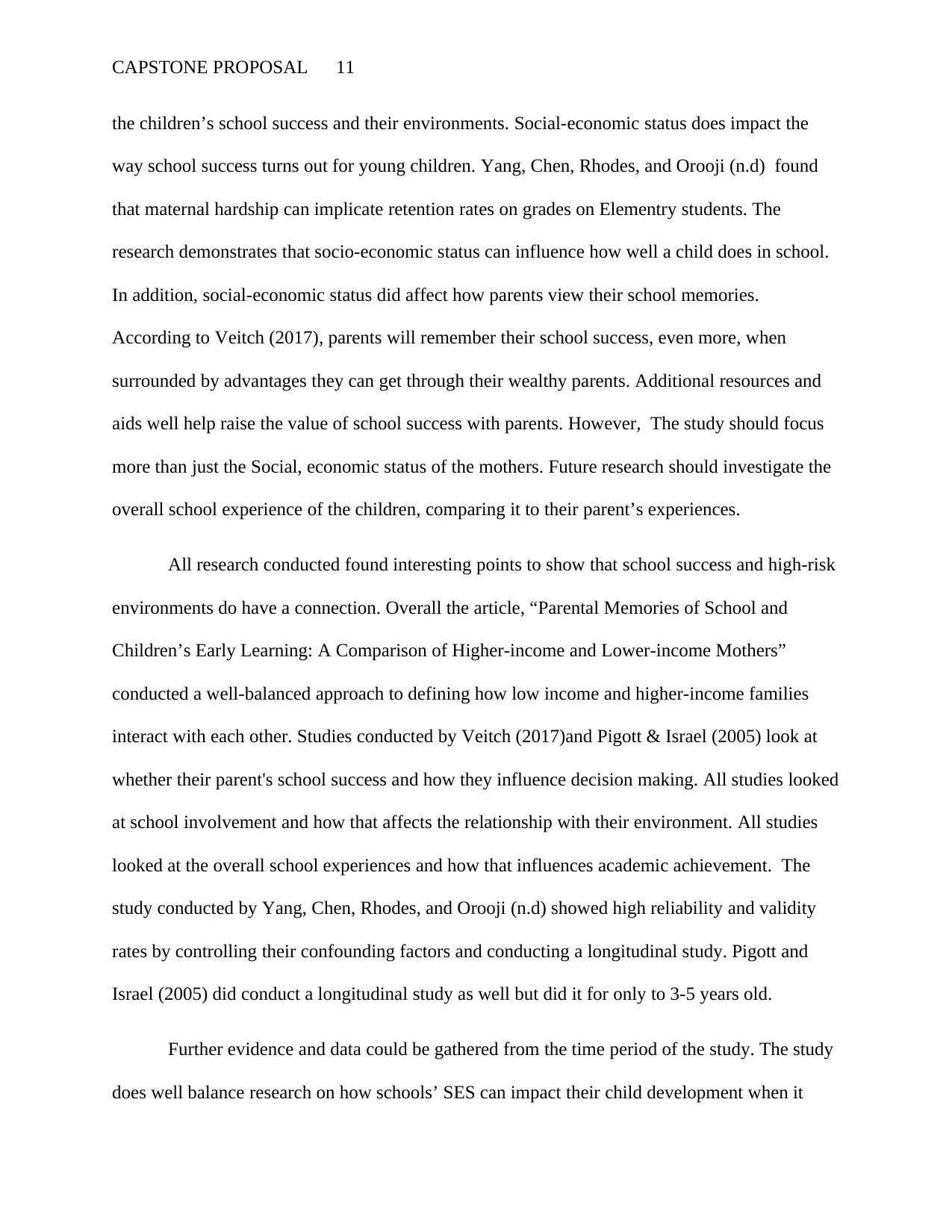
CAPSTONE PROPOSAL 11
the children’s school success and their environments. Social-economic status does impact the
way school success turns out for young children. Yang, Chen, Rhodes, and Orooji (n.d) found
that maternal hardship can implicate retention rates on grades on Elementry students. The
research demonstrates that socio-economic status can influence how well a child does in school.
In addition, social-economic status did affect how parents view their school memories.
According to Veitch (2017), parents will remember their school success, even more, when
surrounded by advantages they can get through their wealthy parents. Additional resources and
aids well help raise the value of school success with parents. However, The study should focus
more than just the Social, economic status of the mothers. Future research should investigate the
overall school experience of the children, comparing it to their parent’s experiences.
All research conducted found interesting points to show that school success and high-risk
environments do have a connection. Overall the article, “Parental Memories of School and
Children’s Early Learning: A Comparison of Higher-income and Lower-income Mothers”
conducted a well-balanced approach to defining how low income and higher-income families
interact with each other. Studies conducted by Veitch (2017)and Pigott & Israel (2005) look at
whether their parent's school success and how they influence decision making. All studies looked
at school involvement and how that affects the relationship with their environment. All studies
looked at the overall school experiences and how that influences academic achievement. The
study conducted by Yang, Chen, Rhodes, and Orooji (n.d) showed high reliability and validity
rates by controlling their confounding factors and conducting a longitudinal study. Pigott and
Israel (2005) did conduct a longitudinal study as well but did it for only to 3-5 years old.
Further evidence and data could be gathered from the time period of the study. The study
does well balance research on how schools’ SES can impact their child development when it
the children’s school success and their environments. Social-economic status does impact the
way school success turns out for young children. Yang, Chen, Rhodes, and Orooji (n.d) found
that maternal hardship can implicate retention rates on grades on Elementry students. The
research demonstrates that socio-economic status can influence how well a child does in school.
In addition, social-economic status did affect how parents view their school memories.
According to Veitch (2017), parents will remember their school success, even more, when
surrounded by advantages they can get through their wealthy parents. Additional resources and
aids well help raise the value of school success with parents. However, The study should focus
more than just the Social, economic status of the mothers. Future research should investigate the
overall school experience of the children, comparing it to their parent’s experiences.
All research conducted found interesting points to show that school success and high-risk
environments do have a connection. Overall the article, “Parental Memories of School and
Children’s Early Learning: A Comparison of Higher-income and Lower-income Mothers”
conducted a well-balanced approach to defining how low income and higher-income families
interact with each other. Studies conducted by Veitch (2017)and Pigott & Israel (2005) look at
whether their parent's school success and how they influence decision making. All studies looked
at school involvement and how that affects the relationship with their environment. All studies
looked at the overall school experiences and how that influences academic achievement. The
study conducted by Yang, Chen, Rhodes, and Orooji (n.d) showed high reliability and validity
rates by controlling their confounding factors and conducting a longitudinal study. Pigott and
Israel (2005) did conduct a longitudinal study as well but did it for only to 3-5 years old.
Further evidence and data could be gathered from the time period of the study. The study
does well balance research on how schools’ SES can impact their child development when it
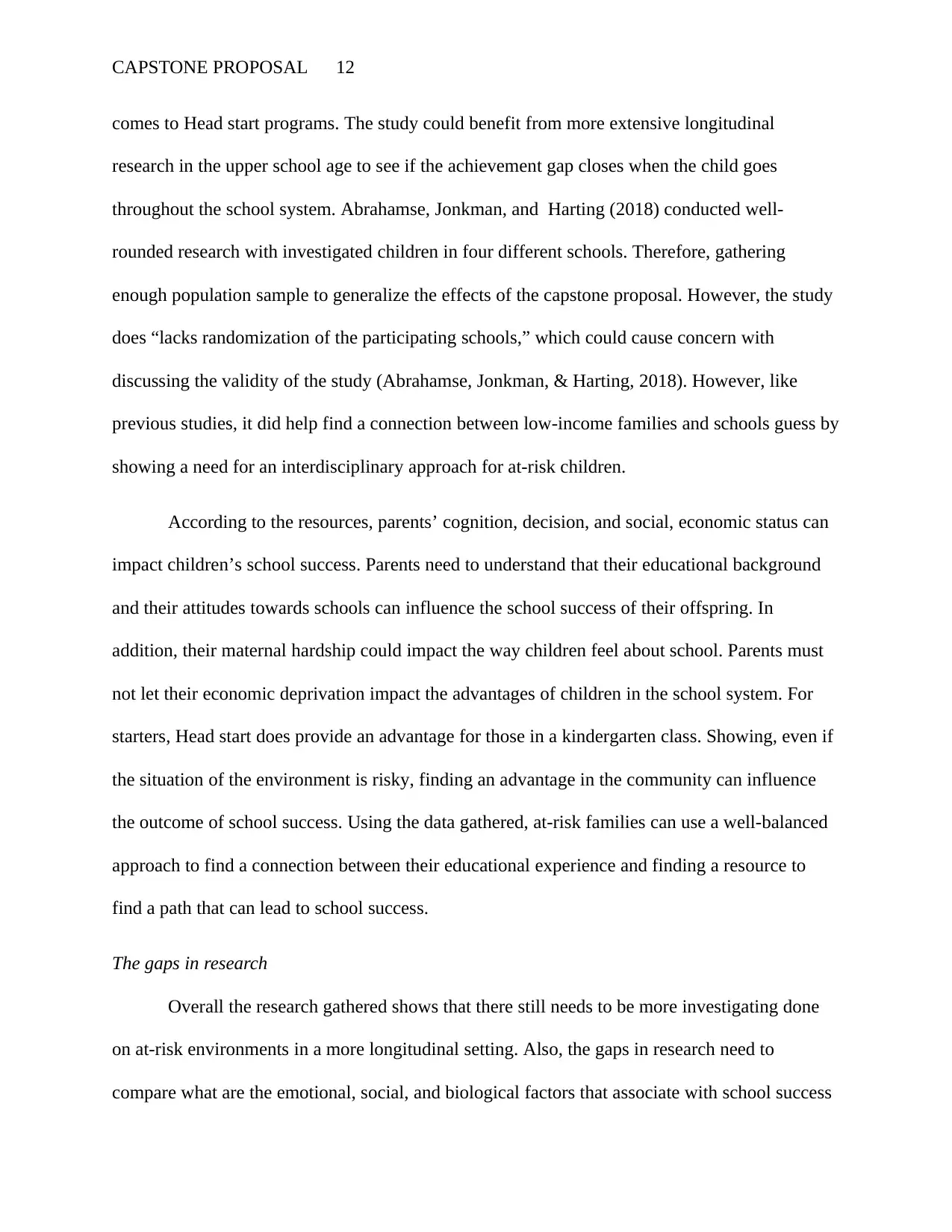
CAPSTONE PROPOSAL 12
comes to Head start programs. The study could benefit from more extensive longitudinal
research in the upper school age to see if the achievement gap closes when the child goes
throughout the school system. Abrahamse, Jonkman, and Harting (2018) conducted well-
rounded research with investigated children in four different schools. Therefore, gathering
enough population sample to generalize the effects of the capstone proposal. However, the study
does “lacks randomization of the participating schools,” which could cause concern with
discussing the validity of the study (Abrahamse, Jonkman, & Harting, 2018). However, like
previous studies, it did help find a connection between low-income families and schools guess by
showing a need for an interdisciplinary approach for at-risk children.
According to the resources, parents’ cognition, decision, and social, economic status can
impact children’s school success. Parents need to understand that their educational background
and their attitudes towards schools can influence the school success of their offspring. In
addition, their maternal hardship could impact the way children feel about school. Parents must
not let their economic deprivation impact the advantages of children in the school system. For
starters, Head start does provide an advantage for those in a kindergarten class. Showing, even if
the situation of the environment is risky, finding an advantage in the community can influence
the outcome of school success. Using the data gathered, at-risk families can use a well-balanced
approach to find a connection between their educational experience and finding a resource to
find a path that can lead to school success.
The gaps in research
Overall the research gathered shows that there still needs to be more investigating done
on at-risk environments in a more longitudinal setting. Also, the gaps in research need to
compare what are the emotional, social, and biological factors that associate with school success
comes to Head start programs. The study could benefit from more extensive longitudinal
research in the upper school age to see if the achievement gap closes when the child goes
throughout the school system. Abrahamse, Jonkman, and Harting (2018) conducted well-
rounded research with investigated children in four different schools. Therefore, gathering
enough population sample to generalize the effects of the capstone proposal. However, the study
does “lacks randomization of the participating schools,” which could cause concern with
discussing the validity of the study (Abrahamse, Jonkman, & Harting, 2018). However, like
previous studies, it did help find a connection between low-income families and schools guess by
showing a need for an interdisciplinary approach for at-risk children.
According to the resources, parents’ cognition, decision, and social, economic status can
impact children’s school success. Parents need to understand that their educational background
and their attitudes towards schools can influence the school success of their offspring. In
addition, their maternal hardship could impact the way children feel about school. Parents must
not let their economic deprivation impact the advantages of children in the school system. For
starters, Head start does provide an advantage for those in a kindergarten class. Showing, even if
the situation of the environment is risky, finding an advantage in the community can influence
the outcome of school success. Using the data gathered, at-risk families can use a well-balanced
approach to find a connection between their educational experience and finding a resource to
find a path that can lead to school success.
The gaps in research
Overall the research gathered shows that there still needs to be more investigating done
on at-risk environments in a more longitudinal setting. Also, the gaps in research need to
compare what are the emotional, social, and biological factors that associate with school success
⊘ This is a preview!⊘
Do you want full access?
Subscribe today to unlock all pages.

Trusted by 1+ million students worldwide
1 out of 27
Related Documents
Your All-in-One AI-Powered Toolkit for Academic Success.
+13062052269
info@desklib.com
Available 24*7 on WhatsApp / Email
![[object Object]](/_next/static/media/star-bottom.7253800d.svg)
Unlock your academic potential
Copyright © 2020–2025 A2Z Services. All Rights Reserved. Developed and managed by ZUCOL.




